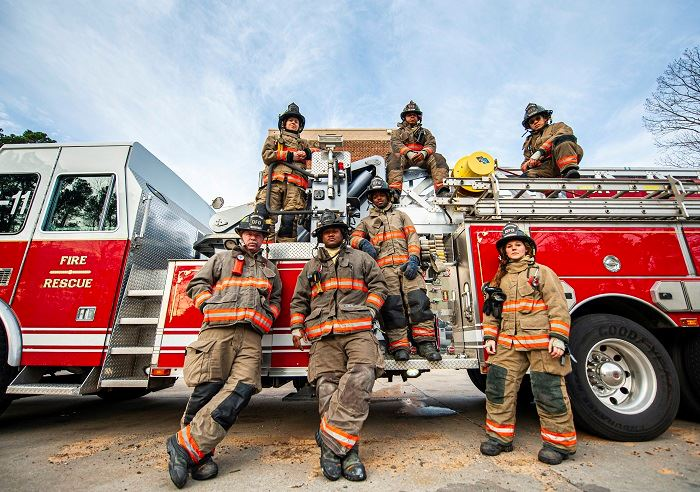Silicone wristbands track firefighters’ exposures to harmful chemicals
Firefighters have a 9 percent higher risk of being diagnosed with cancer and a 14 percent higher risk of dying from the disease than average

[May 28, 2022: Timothy Lucas, Duke University]
New Duke University research shows that silicone wristbands can be used to track firefighters’ exposures to 134 dangerous chemicals, including PFAS. (CREDIT: Durham, NC, Fire Department)
Firefighters have a 9 percent higher risk of being diagnosed with cancer and a 14 percent higher risk of dying from the disease than the general adult U.S. population, according to studies by the National Institute of Occupational Safety and Health and other agencies.
Recent research by scientists at Duke University could give doctors and public health officials a new tool for tracking firefighters’ exposures to cancer-causing chemicals and determining where and when the risks might be greatest.
The cool thing is, it’s not some expensive high-tech gadget. It’s just a silicone wristband, purchased in bulk for about $1 apiece.
“It turns out that ordinary silicone wristbands, like the ones sold in stores, absorb the semi-volatile organic compounds you’re exposed to while you’re out in the world,” said Jessica Levasseur, a PhD student at Duke’s Nicholas School of the Environment, who led the study.
“It’s like taking fingerprints of everywhere you’ve been and everything you’ve been exposed to,” Levasseur said.
The decision to use the bands to track firefighters’ risks came about when the Durham Fire Department (DFD) approached Duke researchers for help identifying exposure risks its firefighters faced.
Related Stories:
“Firefighters have high cancer rates compared to the general population, but we don’t know why,” Levasseur said.”Is it caused by exposure to one chemical or a mix of them? Is it something they breathe in while working in fires or being near them? Or something else? There are lots of risk factors and potential routes of exposure, and we wanted to see if silicone wristbands could be a practical tool for disentangling them.”
Working with other researchers at the Nicholas School and the Duke Cancer Institute, she asked 20 firefighters from DFD to wear the wristbands while working a typical six-day shift, and then to get each firefighter’s baseline exposures, while off duty.
Each wristband was analyzed for 134 different chemical compounds, including phthalates, brominated flame retardants, organophosphate esters, polycyclic aromatic hydrocarbons (PAH), and per- and polyfluoroalkyl substances (PFAS), all of which have been linked to increased incidence of certain cancers.
“Seventy-one of these chemicals — including seven PFAS, which to our knowledge have never previously been detected using wristbands — were found in at least half of the bands,” Levasseur said.
Levels of PAH, brominated flame retardants and organophosphate esters were 0.5 to 8.5 times higher in the wristbands worn while on duty than in those worn while off duty. This suggests that just being a firefighter means you are exposed to more of these compounds than the average adult, regardless of whether you respond to a fire while working.
Bands worn by firefighters on days they actively fought a fire also contained 2.5 times more PFOS — a type of PFAS — than the bands of firefighters who were not called to a fire. This suggests that exposure to these contaminants is strongly associated with active firefighting, Levasseur said.
In contrast, wristbands worn on off-duty days contained higher levels of phthalates and pesticides.
“This research is the first to demonstrate that silicone wristbands can be used to quantify occupational exposure in firefighters and distinguish exposures that may be related to fire events versus other sources,” Levasseur said. “Conducting follow-up research with a larger population will help pinpoint the exposure sources that contribute to firefighters' risk for cancer and assess exposure risks that may be related to chemicals off-gassing from their gear or materials in their firehouse, which we did not examine,” she said.
She and her colleagues published their peer-reviewed findings in the journal Science of the Total Environment.
Levasseur’s co-authors on the new study were Dr. Kate Hoffman, Dr. Nicholas J. Herkert, Dr. Ellen Cooper, Duncan Hay and Dr. Heather M. Stapleton, all of Duke’s Nicholas School of the Environment.
For more science and technology news check out our New Innovations section at The Brighter Side of News.
Note: Materials provided above by Duke University. Content may be edited for style and length.
Like these kind of feel good stories? Get the Brighter Side of News' newsletter.
Tags: #New_Innovations, #Firefighters, #Fires, #Exposure, #Harmful_Chemicals, #Wearables, #Cancer, #Technology, #The_Brighter_Side_of_News
Joseph Shavit
Head Science News Writer | Communicating Innovation & Discovery
Based in Los Angeles, Joseph Shavit is an accomplished science journalist, head science news writer and co-founder at The Brighter Side of News, where he translates cutting-edge discoveries into compelling stories for a broad audience. With a strong background spanning science, business, product management, media leadership, and entrepreneurship, Joseph brings a unique perspective to science communication. His expertise allows him to uncover the intersection of technological advancements and market potential, shedding light on how groundbreaking research evolves into transformative products and industries.



